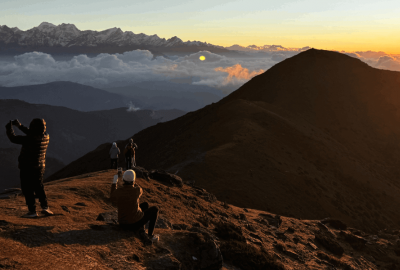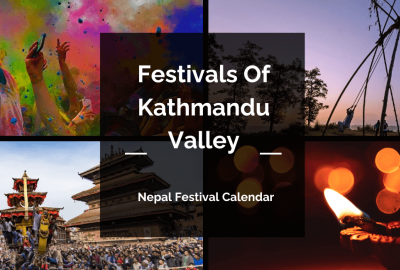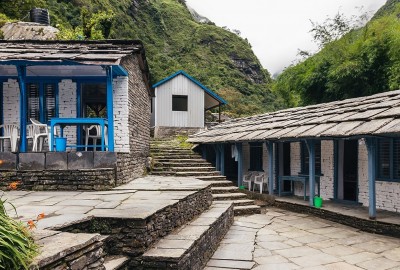Bhaktapur is one of the three major cities of Kathmandu valley and it retains a good chunk of its ancient ways of life. With exquisite architecture, metal craft and remarkable wood carvings, Bhaktapur takes us back in time to the Malla dynasty who indulged in art like no other dynasty.
Table of Contents
Plan your trip to Nepal
Customize your trip with help from a local travel specialist.
With pagoda style temples that rise above the Bhaktapur skyline, devotees still celebrate age-old traditions in the durbar square and pottery square which date back to the 12th century. The temple squares are Bhaktapur's main attraction and are vibrant to this day. The Bhaktapur durbar square is listed on the UNESCO World Heritage Site list.
In 1482, King Yakshya Malla divided the kingdom into three parts for his three sons. Before that, it was ruled by only one king. The division created disunity and fading strength, hence, the Shah dynasty from Gorkha was able to conquer it one by one. Despite the other two cities in Kathmandu valley, Bhaktapur has not changed much. Many women can be seen in the black and red traditional Newari attire.
They have also retained the culture by doing pottery, farming, singing in the temple to by simply sitting in the rest houses between dawn and dusk. Previously Bhaktapur was known as Bhadgaon in Nepali and Khwopa in Newari. Festivals that last over a week are some of the ways that it has managed to maintain their original elaborate functions.
History of Bhaktapur
Founded by King Ananda Malla in the 12th century, Bhaktapur was the capital city of the Greater Malla Kingdom until the 15th century and until the 18th century was an independent kingdom. Jitamitra Malla, Bhupatindra Malla, and Ranjit Malla were the last three Malla rulers of Bhaktapur. These kings played important roles in the building of palaces and temples of Durbar Square.
Prithvi Narayan Shah in 1744 began a conquest march in Kathmandu valley. He was the founder of the Gorkha dynasty and he captured and unified Patan, Kathmandu, Bhaktapur and the smaller towns of the valley under one rule.
Jang Bahadur Kunwar Ranaji took control of Nepal in 1846 after a period of bloody coup and instability. Until 1951 his Rana dynasty ruled Nepal. After 1951 a new government was formed by the Congress Party. King Mahendra in 1960 took control and banned political parties and then instituted land reforms. Throughout the late 20th century, political unrest continued.
Over 2000 houses were destroyed and more were damaged by the earthquake in 1934. More than 1000 people died and restoration on buildings was undertaken over the years. The restoration process was funded by the U.S. in the 1990s and West Germany in the late 1980s.
Culture
While primarily the population of the city is Hindu, Hindu and Buddhist religious sites and art fill Bhaktapur. At Indra Varna Mahavihar, there are nineteen Buddhist monasteries built in 1671 and located in between Dattatraya Square and Durbar Square. A water spout (Patinga Hiti), prayer wheels, two lion statues, and tantric wood-carved windows can be seen there. Buddhist shrines and monuments including Chatu Brahma Mahavihar, Prasannasheel Mahavihar, Dipankar Mahavihar, Lokeswor Mahavihar, Sukra-varna Mahavihar can be seen here.
There are many celebrations observed here throughout the year to pay tribute to the gods, mark the seasons and to remember legendary and historical events. Few of them are listed below:
Dashain
Lasting 15 days, this is the longest festival of the year. It is celebrated to honor the goddess Devi Durga who is believed to have slain the son of Ruru, demon Durga. Thousands of animals are sacrificed here as an offering to the goddess. This festival is observed in September or October.
Gai-Jatra (the Cow Festival)
Celebrated by the families in misfortune, every family who has lost someone in the past year takes part in the festival with a cow or a young boy dressed as a cow. It is believed that the cow helps the deceased to reach heaven. This festival is celebrated in July or August.
Bisket Jatra (the Nepalese New Year celebration)
Chariots are pulled through the streets and a tug of the war determines who will be the recipient of good fortune for the year. This festival takes place in April.
Tihar (the Festival of lights)
This festival celebrates the goddess of wealth, Goddess Laxmi. In this festival, Nepalese light up their homes with candles and oil lamps to invite goddess Laxmi into their homes. Crows, dogs, and cows are also celebrated here along with a day set aside to honor brothers. The Mha Puja is the Newari new year and it is a day to celebrate one's own body and life. It is celebrated in October.
Places to Visit in Bhaktapur
Bhaktapur is filled with architectural beauty, ancient Hindu and Buddhist religious sites and palaces and courtyards where travelers can easily spend the day while observing the traditions and culture of Newars.
Bhaktapur Durbar Square
After the earthquake of 1934, almost ⅓ of the monasteries, ancient temples, and other religious monuments were destroyed. Fortunately, most of these gems are still standing tall. The 55 window palace used to serve as the seat of royalty prior to 1769. The palace has gorgeously carved windows and doors and houses the National Art Gallery.
Yachheswor Mahadev Temple
Located just outside the palace and at the entrance to the Taleju Temple Complex is the Golden Gate. It was built in 1756, and the royal bath with its golden faucet also lies there.
Nyatapola Temple
Built-in 1702 A. D. by King Bhupatindra Malla, the Nyatapola temple is a 5 storied pagoda style temple. In the Newari language, Nyatapola means "five-tiered” a symbolic representation of five basic elements of nature. It is also the biggest, highest and most famous pagoda style temple ever built in Nepal. This temple is dedicated to the Goddess of success and extreme power, Siddhi Laxmi. This is a temple has been built with artistic beauty and perfection.
Bhairav Nath Temple
Originally built as a one-storied temple by Jagat Jyoti Malla, in the years that followed, King Bhupatindra Malla added two more stories to it in 1718 A.D. This temple is dedicated to the manifestation of Lord Shiva as Bhairava the God of terror and death.
Dattatreya Square
Many of Bhaktapur's Hindu monasteries, as well as temples and museums, lies in this square. The Dattatreya temple was built in 1428 by King Yaksha Malla. It has statues of the Hindu trinity and is a three-story pagoda-style temple. According to legends, the building was made from a single piece of wood from one tree.
Two large sculptures of the Jaiput wrestlers, Jaimala and Pata are at the entrance of the temple. A chakra and a gilded metal statue of a bird-like divinity named Garuda is also there. There are wood carved panels with erotic decorations around the temple. Pottery square where potters work and display their handicrafts is also present in Dattatreya Square.
Nagarkot
Nagarkot lies at an altitude of 2175 m and offers a panoramic view of the Himalayas and Mt Everest. It lies 20 km northeast of Bhaktapur and is the second-highest point in Kathmandu valley. The area has hiking trails which lead into Tamang villages.
Changu Narayan
Built by King Mandev in 464 AD, Changu Narayan is the oldest temple in the valley. It is situated 6 km north of Bhaktapur. You can get from here to Nagarkot from a popular hiking trail.
Thimi
Known for its handicrafts and vegetable gardens, Thimi is a traditional Newar city. It is located about 5 km west of Bhaktapur.
Surya Vinayak Shrine
This shrine is just a 10 to 20-minute walk from Bhaktapur and the Hindu god Ganesh is worshipped here. It is located at the top of a hill in a forest.








